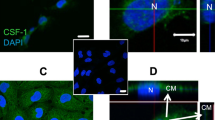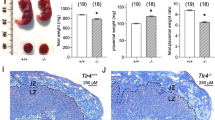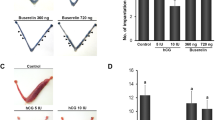Abstract
The semi-allograft embryo in the blastocyst stage implants itself in the endometrium, yet no immune rejection processes are activated. Embryonic trophoblast and maternal decidua produce corticotropin-releasing hormone (CRH) and express Fas ligand (FasL), a proapoptotic cytokine. We found that antalarmin, a CRH receptor type 1 antagonist, decreased FasL expression and promoted apoptosis of activated T lymphocytes, an effect which was potentiated by CRH and inhibited by antalarmin. Female rats treated with antalarmin showed a marked decrease in implantation sites and live embryos and diminished endometrial FasL expression. Embryos from mothers that lacked T cells or from syngeneic matings were not rejected when the mothers were given antalarmin. These findings suggested that locally produced CRH promotes implantation and maintenance of early pregnancy primarily by killing activated T cells.
This is a preview of subscription content, access via your institution
Access options
Subscribe to this journal
Receive 12 print issues and online access
$209.00 per year
only $17.42 per issue
Buy this article
- Purchase on Springer Link
- Instant access to full article PDF
Prices may be subject to local taxes which are calculated during checkout






Similar content being viewed by others
References
Gill, T. J. Immunological and genetic factors influencing pregnancy and development. Am. J. Reprod. Immunol. Microbiol. 10, 116–120 (1986).
Nagata, S. Fas and Fas ligand: a death factor and its receptor. Adv. Immunol. 57, 129–144 (1994).
Suda, T. et al. Expression of the Fas ligand in cells of T cell lineage. J. Immunol. 154, 3806–3813 (1995).
Bellgrau, D. et al. A role for CD95 ligand in preventing graft rejection. Nature 377, 630–632 (1995).
Griffith, T. S., Yu, X., Herndton, J. M., Green, D. R. & Ferguson, T. A. CD95-induced apoptosis of lymphocytes in an immune privileged site induces immunological tolerance. Immunity 5, 7–16 (1996).
Nagata, S. Apoptosis by death factor. Cell 88, 355–365 (1997).
Huang, D. C. et al. Activation of Fas by FasL induces apoptosis by a mechanism that cannot be blocked by Bcl-2 or Bcl-x(L). Proc. Natl Acad. Sci. USA 96, 14871–14876 (1999).
Bamberger, A. M. et al. Expression of the apoptosis-inducing Fas ligand (FasL) in human first and third trimester placenta and choriocarcinoma cells. J. Clin. Endocrinol. Metab. 82, 3173–3175 (1997).
Kauma, S. W., Huff, T. F., Hayes, N. & Nilkaeo, A. Placental Fas ligand expression is a mechanism for maternal immune tolerance to the fetus. J. Clin. Endocrinol. Metab. 84, 2188–2194 (1999).
McIntyre, J. A. & Faulk, W. P. Trophoblast antigens in normal and abnormal human pregnancy. Clin. Obstet. Gynecol. 29, 976–98 (1986).
Martin, J. N. Jr et al. The interrelationship of eclampsia, HELLP syndrome, and prematurity: cofactors for significant maternal and perinatal risk. Br. J. Obstet. Gynaecol. 100, 1095–1100 (1993).
Grino, M., Chrousos, G. P. & Margioris, A. N. The corticotropin releasing hormone gene is expressed in human placenta. Biochem. Biophys. Res. Commun. 148, 1208–1214 (1987).
Makrigiannakis, A. et al. The corticotropin-releasing hormone (CRH) in normal and tumoral epithelial cells of human endometrium. J. Clin. Endocrinol. Metab. 80, 185–189 (1995).
Frim, D. M. et al. Characterization and gestational regulation of corticotropin-releasing hormone messenger RNA in human placenta. J. Clin. Invest. 82, 287–292 (1988).
Petraglia, F., Sawchenko, P. E., Rivier, J. & Vale, W. Evidence for local stimulation of ACTH secretion by corticotropin-releasing factor in human placenta. Nature 328, 717–719 (1987)
Petraglia, F. et al. Human decidua and in vitro decidualized endometrial stromal cells at term contain immunoreactive corticotropin-releasing factor (CRF) and CRF messenger ribonucleic acid. J. Clin. Endocrinol. Metab. 74, 1427–1431 (1992).
Jones, S. A., Brooks, A. N. & Challis, J. R. Steroids modulate corticotropin-releasing hormone production in human fetal membranes and placenta. J. Clin. Endocrinol. Metab. 68, 825–830 (1989).
Mastorakos, G. et al. Presence of immunoreactive corticotropin releasing hormone (CRH) in human endometrium. J. Clin. Endocrinol. Metab. 81, 1046–1050 (1996).
Clifton, V. L. et al. Corticotropin-releasing hormone and proopiomelanocortin-derived peptides are present in human myometrium. J. Clin. Endocrinol. Metab. 83, 3716–3721 (1998).
Di Blasio, A. M. et al. Expression of corticotropin-releasing hormone and its R1 receptor in human endometrial stromal cells. J. Clin. Endocrinol. Metab. 82, 1594–1597 (1997).
Rogers, P. A. Early endometrial microvascular response during implantation in the rat. Reprod. Fertil. Dev. 4, 261–264 (1992).
Psychoyos, A., Nikas, G. & Gravanis, A. The role of prostaglandins in blastocyst implantation. Hum. Reprod. 10, 30–42 (1995).
Chrousos, G. P. et al. The corticotropin-releasing factor stimulation test. An aid in the evaluation of patients with Cushing's syndrome. N. Engl. J. Med. 310, 622–626 (1984).
Karalis, K. et al. Autocrine or paracrine inflammatory actions of corticotropin-releasing hormone in vivo. Science 254, 421–423 (1991).
Chrousos, G. P., Torpy. D. J. & Gold, P. W. Interactions between the hypothalamic-pituitary-adrenal axis and the female reproductive system: clinical implications. Ann. Intern. Med. 129, 229–240 (1998).
Webster, E. L. et al. In vivo and in vitro characterization of antalarmin, a nonpeptide corticotropin-releasing hormone (CRH) receptor antagonist: Suppression of pituitary ACTH release and peripheral inflammation. Endocrinology 137, 5747–5750 (1996).
Udelsman, R., Gallucci, W. T., Bacher, J., Loriaux, D. L. & Chrousos, G. P. Hemodynamic effects of corticotropin releasing hormone in the anesthetized cynomolgus monkey. Peptides 7, 465–471 (1986).
Theoharides, T. C. et al. Corticotropin-releasing hormone induces skin mast cell degranulation and increased vascular permeability, a possible explanation for its proinflammatory effects. Endocrinology 139, 403–413 (1998).
Makrigiannakis, A. et al. Corticotropin-releasing hormone (CRH) is expressed at the implantation sites of early pregnant rat uterus. Life Sci. 57, 1869–1875 (1995).
Athanassakis, I., Farmakiotis, V., Aifantis, I., Gravanis, A. & Vassiliadis, S. Expression of corticotrophin-releasing hormone in the mouse uterus: participation in embryo implantation. J. Endocrinol. 163, 221–227 (1999).
Zoumakis, E. et al. Corticotrophin-releasing hormone (CRH) interacts with inflammatory prostaglandins and interleukins and affects the decidualization of human endometrial stroma. Mol. Hum. Reprod. 6, 344–351 (2000).
Phillips, T. A. et al. TRAIL (Apo-2L) and TRAIL receptors in human placentas: implications for immune privilege. J. Immunol. 162, 6053–6059 (1999).
Runic, R., Lockwood, C. J., Ma, Y., Dipasquale, B. & Guller, S. Expression of Fas ligand by human cytotrophoblasts:implication in placentation and fetal survival. J. Clin. Endocrinol. Metab. 81, 3119–3122 (1996).
Sakuragi, N. et al. Differentiation-dependent expression of the BCL-2 proto-oncogene in the human trophoblast lineage. J. Soc. Gynecol. Invest. 1, 164–172 (1994).
Lockwood, C. J. et al. The role of progestationally regulated stromal cell tissue factor and type-1 plasminogen activator inhibitor (PAI-1) in endometrial hemostasis and menstruation. Ann. NY Acad. Sci. 734, 57–79 (1994).
Lockwood, C. J. Recent advances in elucidating the pathogenesis of preterm delivery, the detection of patients at risk, and preventative therapies. Curr. Opin. Obstet. Gynecol. 6, 7–18 (1994).
Psychoyos, A. Uterine receptivity for nidation. Ann. NY Acad. Sci. 476, 36–42 (1986).
Smith, G. W. et al. Corticotropin releasing factor receptor 1-deficient mice display decreased anxiety, impaired stress response, and aberrant neuroendocrine development. Neuron 20, 1093–1102 (1998).
Muglia, L., Jacobson, L., Dikkes, P. & Majzoub, J. A. Corticotropin-releasing hormone deficiency reveals major fetal but not adult glucocorticoid need. Nature 373, 427–432 (1995).
Bornstein, S. R. et al. Chronic effects of a nonpeptide corticotropin-releasing hormone type I receptor antagonist on pituitary adrenal function, body weight, and metabolic regulation. Endocrinology 139, 1546–1555 (1998).
Wong, M. L. et al. Chronic administration of the non-peptide CRH type 1 receptor antagonist antalarmin does not blunt hypothalamic-pituitary-adrenal axis responses to acute immobilization stress. Life Sci. 65, PL53–58 (1999).
Habib, K. E. et al. Oral administration of a corticotropin-releasing hormone receptor antagonist significantly attenuates behavioral, neuroendocrine, and autonomic responses to stress in primates. Proc. Natl Acad. Sci. USA 97, 6079–6084 (2000).
Chan, E. C. et al. A corticotropin-releasing hormone type I receptor antagonist delays parturition in sheep. Endocrinology 139, 3357–3360 (1998).
Nathanielsz, P. W. Life in the Womb: The origin of health and disease. (Promethean Press. Ithaca, NY, 1999).
Aboagye-Mathiesen, G., Zdravkovic, M., Toth, F. D. & Ebbesen, P. Effects of human trophoblast-induced interferons on the expression of c-fms/CSF-1R, EGF-R and c-erbB2 in invasive and non-invasive trophoblast. Placenta 18, 155–161 (1997).
Bamberger, A. M. et al. The adhesion molecule CEACAM1 (CD66a, C-CAM, BGP) is specifically expressed by the extravillous intermediate trophoblast. Am. J. Pathol. 156, 1165–1170 (2000).
Fischer, S. J. et al. Adhesive and degradative properties of human placental trophoblast cells in vivo. J. Cell. Biol. 109, 891–902 (1989).
Graham, C. H. et al. Establishment and characterization of first trimester human trophoblast cells with extended life-span. Exp. Cell. Res. 206, 204–211 (1993).
Bradford, M. M. A rapid and sensitive method for the quantitation of microgram quantities of protein utilizing the principle of protein-dye binding. Anal. Biochem. 72, 248–254 (1976).
Makrigiannakis, A. et al. N-cadherin-mediated human granulosa cell adhesion prevents apoptosis. A role in follicular atresia and luteolysis? Am. J. Pathol. 154, 1391–1406 (1999).
Laemmni, U. K. Cleavage of structural proteins during the assembly of the head of bacteriophage T4. Nature 227, 680–685 (1970).
Towbin, H., Stachelin, T. & Gordon, J. Electrophoretic transfer of proteins from polyacrylamide gels to nitrocellulose sheets: procedure and some applications. Proc. Natl Acad. Sci. USA 76, 4350–4354 (1979).
McGahon, A. J. et al. The end of the (cell) line: methods for the study of apoptosis in vitro. Meth. Cell. Biol. 46, 153–185 (1995).
Bortner, D. M. & Rosenberg, M. P. Overexpression of cyclin A in the mammary glands of transgenic mice results in the induction of nuclear abnormalities and increased apoptosis. Cell Growth Differ. 6, 1579–1589 (1995).
Makrigiannakis, A., Amin, K., Coukos, G., Tilly, J. L. & Coutifaris, C. Regulated expression and potential roles of p53 and Wilms' tumor suppressor gene (WT1) during follicular development in the human ovary. J. Clin. Endocrinol. Metab. 85, 449–459 (2000).
Acknowledgements
Supported by a grant from the Alexander Onassis Foundation (to A. M.).
Author information
Authors and Affiliations
Corresponding authors
Rights and permissions
About this article
Cite this article
Makrigiannakis, A., Zoumakis, E., Kalantaridou, S. et al. Corticotropin-releasing hormone promotes blastocyst implantation and early maternal tolerance. Nat Immunol 2, 1018–1024 (2001). https://doi.org/10.1038/ni719
Received:
Accepted:
Published:
Issue Date:
DOI: https://doi.org/10.1038/ni719
This article is cited by
-
The expression of corticotropin-releasing hormone family peptides in premalignant and malignant vulvar lesions
Clinical and Translational Oncology (2023)
-
The Link Between Stress and Endometriosis: from Animal Models to the Clinical Scenario
Reproductive Sciences (2020)
-
A repeated measures study of phenol, paraben and Triclocarban urinary biomarkers and circulating maternal hormones during gestation in the Puerto Rico PROTECT cohort
Environmental Health (2019)
-
Endometrial CRH and implantation: from bench to bedside
Hormones (2018)
-
Induction of apoptosis in breast cancer cells in vitro by Fas ligand reverse signaling
Journal of Cancer Research and Clinical Oncology (2018)



